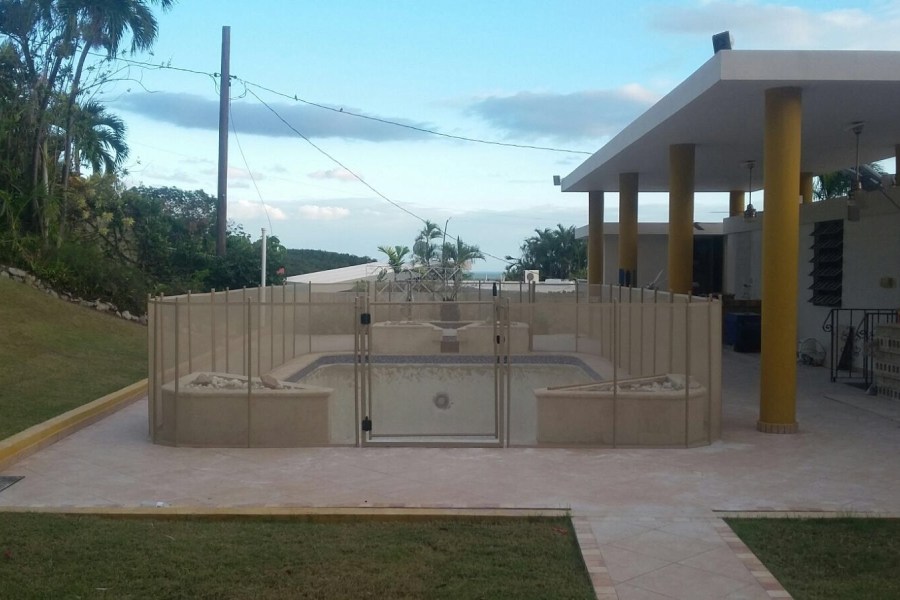If you own a swimming pool in Florida, understanding and complying with the current Florida pool fence law is not just a good idea; it’s a legal necessity. Every year, unprotected swimming pools are the scene of preventable accidents, especially involving children and elderly individuals.
Drowning remains a leading cause of accidental death for children under five in Florida, which is a sobering fact that led to the creation of strict pool safety legislation statewide.
Whether you’re installing a new pool, purchasing a home with an existing one, or updating an older barrier system, staying compliant with Florida pool fence laws in 2025 is crucial to avoid legal penalties and, more importantly, protect lives.

Florida leads the nation in drowning fatalities among young children. To reduce preventable tragedies, the Florida Legislature passed the Residential Swimming Pool Safety Act, officially Chapter 515 of the Florida Statutes.
Under this law, any residential pool, spa, or hot tub constructed after October 1, 2000, must include at least one approved safety feature to restrict unsupervised access. This law applies uniformly across the state. Whether you are in Orlando, Sarasota, or Tampa Bay, these requirements are the legal baseline for ensuring your pool is secure and compliant.
The goal of this law is simple: prevent accidents by requiring physical barriers or safety alarms that delay or deny unsupervised entry, especially for children, the elderly, and individuals with disabilities.
To comply with the Florida pool fence code, your residential pool must include one of the following safety features, each with strict specifications. Here’s what the Florida pool fence requirements state:
Under the Florida pool fence law, every residential pool must have a pool barrier that stands at least four feet (48 inches) tall, measured from the outside ground level. This minimum height is intended to block unsupervised access, especially by small children who might otherwise climb over or through an improperly constructed fence. Whether you opt for a permanent installation or a more flexible solution, such as a removable pool fence, the minimum height rule still applies.
For homeowners seeking a compliant and stylish solution, Pool Guard™, a trusted Florida-based brand, offers ASTM-certified temporary and removable mesh pool fences that meet these statewide and county-specific requirements. These pool safety barriers are designed for both safety and convenience, making them a popular choice for families across Florida.
The fence structure must not contain any openings, gaps, protrusions, or footholds that could allow a child to crawl under, squeeze through, or climb over. In case of fence openings, Florida restricts the size of the openings to be no larger than 4 inches in diameter. This size is determined based on the average shoulder width and body depth of a youngster.
As an exception to this rule are the chain-link fences. For chain-link fences, Florida law allows a maximum mesh size of 1 ¼ inches, unless the fence includes slats fastened at the top and bottom to prevent climbing, at which point a larger mesh size may be allowed.
Keep in mind that additional rules apply to fences with horizontal and vertical members. More specifically:
This part of the Florida pool fence code aligns with national safety standards like ASTM F2286, particularly when using mesh fencing systems.
Answer the questions honestly to assess your compliance. If you’re unsure about any answers, it might be time to review the regulations or consult a professional.
Let’s find out if your pool area is up to code!
All gates that provide access to the pool must:
This prevents young children from accessing the pool even if the gate is accidentally left fully open. These specs are mandatory under both residential and Florida commercial pool fence requirements, especially for rental properties or homes with visitors.
For homeowners seeking a highly reliable and code-compliant locking solution, the MagnaLatch Safety Gate Latch is a top recommendation. Trusted by pool safety professionals and compliant with Florida pool fence code standards, Magna Latch is magnetically triggered, key-lockable, and built to resist tampering.
One of the most overlooked yet critical aspects of the Florida pool fence law is the required placement of the barrier in relation to the pool itself. The law states that a pool barrier must be positioned far enough away from the pool’s edge to prevent someone, especially a child, from falling directly into the water if they manage to breach the barrier. This spatial buffer is critical for giving parents or caretakers time to respond.
Some counties, including Orlando (Orange County), specifically enforce a minimum five-foot clearance between the barrier and the water’s edge.
When planning your pool layout or retrofitting an older barrier, this spatial requirement is just as important as height or latch specifications.
Many homes in Florida have one or more doors that open directly from the house into the pool area. When this occurs, and the house wall becomes part of the pool’s enclosure, it must meet specific safety criteria to comply with the Florida pool fence requirements.
To be fully compliant, the wall of the home must not contain any doors or windows that provide direct access to the pool area. Or all doors and windows that lead to the pool must be equipped with:
If any door or window within the pool barrier opens directly to the pool, follow the pool fence requirements in Florida:
Homeowners may choose yet another alternative safety measure- safety pool covers that are ASTM-compliant, capable of holding weight, and preventing entry.
Pet doors that open directly into the pool area are not permitted as part of a compliant pool barrier under Florida law. These openings must be permanently sealed or located outside the required enclosure.
A doggy door is considered an unprotected access point, and if it leads to the pool, the home cannot be used as part of the barrier, unless that access is removed or blocked.
Why? Pet doors are low to the ground and often overlooked, making them a potential entry point for small children, which violates the Florida law pool fence standards.
If sealing off a doggy door isn’t an ideal solution for your home, there’s good news. Pet-friendly pool fences, such as those offered by Pool Guard™, provide a way to safely section off the pool area while still allowing pets access to the yard. These custom mesh barriers are:
Failure to follow the Florida pool fence requirements is classified as a second-degree misdemeanor, punishable by law. However, you have 45 days to correct violations and attend a state-approved drowning prevention program to have charges dropped.
This shows the state’s intent: not to punish, but to educate and protect.
Florida pool fence requirements are enforced statewide under Chapter 515, but some counties, including Tampa Bay, enforce additional reviews and inspection steps. For instance, Hillsborough County requires strict inspections and may call for engineering review for certain barrier types, especially near seawalls or sloped terrain.
Tip: Similar enforcement practices apply in other Florida locations. The Sarasota County pool fence requirements are similar to or the same as the Manatee County pool fence requirements. Pool owners are expected to follow the same inspection protocols and structural standards to meet local compliance.
Tampa’s Hillsborough County has strict inspection procedures and may require engineering review for certain barrier types, particularly near seawalls or slopes.
| Requirement | Details |
| Fence Height | 4 feet minimum, enforced strictly in final inspection |
| Gaps | Cannot exceed 4 inches, including in gates and around hinges. This includes spacing between vertical elements and any decorative cutouts. If the fence includes decorative or diagonal designs, gaps must be limited to 1 3⁄4 inches to prevent climbing and ensure child safety, as per Florida pool fence code and Hillsborough County enforcement. |
| Pool Gates | Must auto-latch that is placed at least at 54 inches height. If a wall serves as a barrier it must meet audible alarm rules. |
| Fence Materials | Approved mesh fences that are fully compliant in Tampa Bay |
Need a legal pool barrier in Tampa Bay? Explore professional pool fence installation and top-rated pool fence installers in Tampa Bay to secure your home today.
Miami-Dade County enforces some of the strictest pool fence regulations in Florida, particularly due to its hurricane risk zone. In addition to complying with Chapter 515 of the Florida Statutes, pool fences must meet specific wind resistance and material standards.
| Requirement | Details |
| Fence Height | 48 inches minimum, with consistent height around the enclosure |
| Gaps | Openings must not exceed 4 inches; spacing is strictly measured. Where there are decorative elements or cutouts within vertical members, the spacing should not exceed 1 ¾ inches in width or 1 ¾ inches to a barrier composed only of diagonal members to prevent children from climbing the fence. |
| Pool Gates | Must swing outward, self-latch, and include alarms if attached to the home. A latching device attached to a mesh pool fence should be placed at a height no lower than 45 inches above ground. |
| Fence Materials | Must meet Miami-Dade wind load codes. Wire, mesh, and wooden fences are allowed as long as they are non-climbable and impenetrable. In hurricane-prone zones, heavy, galvanized wire fences are often installed to withstand strong winds and prevent structural failure during storms. Concrete blocks could serve as a safety barrier. |
Looking for a pool fence in Miami that meets all local codes? Explore trusted pool fence installation in Miami to protect your property and stay compliant with Miami-Dade’s hurricane-rated safety standards.
While Florida state law doesn’t specifically require a permit for pool fences, many counties and cities do. For example, Sarasota County and Hillsborough County (Tampa Bay) often require permits and final inspections before a certificate of occupancy is issued. Always check with your local building department before installation.
Yes, removable mesh pool fences are legal in Florida as long as they meet all structural and spacing requirements outlined in Chapter 515, F.S., and any applicable local ordinances. They must be at least 48 inches tall, self-latching at the gate, and non-climbable.
Not necessarily. You must install at least one safety feature: a compliant fence, a safety cover, or exit alarms. However, if your home wall is part of the pool barrier, alarms on all access points (doors/windows) are required unless other safety features (like fencing) eliminate the need.

Following the Florida pool fence law is about more than just avoiding fines. It’s about protecting lives. From Tampa Bay to Miami, from Sarasota to Fort Myers, the same core principles apply: sturdy barriers, proper gate mechanisms, non-climbable designs, and compliance with local inspections. By investing in a code-compliant pool fence today, you’re making a lasting commitment to safety, responsibility, and peace of mind.
If you’re looking for a high-quality, fully compliant mesh pool fence that meets all Florida and local codes, Pool Guard™ is here to help. Our ASTM-certified pool fences are designed for Florida’s unique conditions, including hurricane zones, and we offer quick installation across the state.
Please fill out the form below with your information. Your local dealer will be notified about your inquiry.
Please fill out the form below with your information. Your local dealer will be notified about your inquiry.